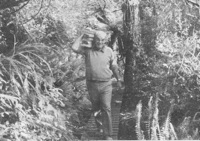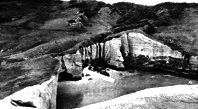P N Johnson, Botany Division, DSIR, Dunedin March 1987
Quarantine Island has a fenced 1.4 ha of low Halls totara – broadleaved forest in excellent condition, plus other native scrub and coastal communities. …
Quarantine and Goat Islands owe their origin to former spurs drowned with the sinking of valleys now occupied by Otago Harbour. Both were used for quarantine purposes in early days of European settlement, and are Crown Land, formerly managed by Health Department. Goat Island has now largely reverted to native low forest and scrub. … Quarantine Island is leased to the St Martins Island community, who maintain a house and other buildings on the eastern headland, and graze sheep over most of the island, except in a fenced-off portion of bush, facing south at the western end. Historical remnants persist in the form of one of the old quarantine buildings, a small graveyard, chimney and flagpole remnants and old wrecks at the boat landing. The island is c. 17 ha in area, and reaches 58 m at its summit. There are two pylons on the crest, carrying electricity from Port Chalmers to Portobello.
Broadleaved – totara forest. This comprises most of the c. 1.4 ha fenced-off area to which sheep do not have access. The canopy, mostly about 4m tall, comprises Halls totara, broadleaf, ngaio, kohuhu, lancewood, peppertree and divaricating shrubs. These last two become more common in the understorey, especially Melicope simplex and Coprosma areolata. Traces remain of shrubs which would previously have been more common: Corokia cotoneaster and Helichrysum aggregatum, while the abundance of mahoe saplings 1m tall indicates that this species will become more common in future. Ground cover is dense, despite the dry stony soil, with Asplenium lyallii, shield fern, Carex forsteri and Libertia ixioides. Creepers are also abundant below and upon the shrubs, especially Scandia, Calystegia, climbing rata, Parsonsia and Clematis paniculata. Condition of this forest is very much better than adjacent grazed forest, or any similar forest remnants on mainland sites on Otago Peninsula.
Cabbage tree – coprosma – totara forest. An eastern portion of the fenced-off bush, probably more open at the time stock were excluded, has cabbage trees above a mixture of windswept totara and Coprosma propinqua scrub. Former grassy openings illustrate the process of regrowth of scrub and forest. The grasses browntop and cocksfoot of the former pasture are being invaded by bidibid, Coprosma propinqua shrubs, and the tall palatable grass Hierochloe redolens.
Flax, some of it possibly planted, is establishing vigorously from seedlings, even among long rank grass, and there are healthy saplings 1m tall of Olearia avicenniaefolia, lancewood, kohuhu and Hebe elliptica.
Coprosma – mixed scrub. Shady faces of the southernmost headland have dense 2-3m scrub of Coprosma propinqua, Halls totara, Melicope, kowhai, ngaio and creepers (mostly Muehlenbeckia australis).
Flax – Hebe scrub. Above the sea shore, in a zone below forest or in patches below pasture, flax grows densely with Hebe elliptica shrubs, and scattered ngaio trees. Patches of bracken are present on some small spurs.
Pasture. On the island crest the main components are browntop, crested dogstail and white clover. Patches of rushes (Juncus gregiflorus, J distegus) occur on moist gentle slopes. Dry crests encourage infestations of barley grass and Scotch thistle (especially common at the south-east end). On sunny faces, Rytidosperma unarede and sweet vernal are common grasses and there are a few patches of silver tussock on upper parts of northern faces. Western faces hold thin, dry, erodible soils between rock outcrops and ledges. Grazing here is heavy, so that the native coastal tussock Poa astonii is reduced to a stubble.
Carex sedgeland. A few small seeps have tussocks of Carex appressa and in one place the tall blue coastal sedge Carex trifida which is of very local occurrence on Otago coasts.
Coastal rocky banks. Some of these are draped with native ice plant, though trampling and grazing prevent this moving up-slope onto ground accessible to sheep. Poa astonii tussock and Linum monogynum are characteristic of rocky outcrops, with other native herbs such as Wahlenbergia gracilis. Easter orchid (Earina autumnalis) surives as a clump atop one northern coastal detached boulder. Crumbling loess banks near the houses have become covered with garde escapes – wallflower, shrubby stonecrop, marguerite daisies and periwinkle.
Coastal herb field in wave-splashed zones. There are small areas of turfy coastal herbs such as Toula dioica, Puccinellia stricta, Crassula moschata, native celery and glsswort. Beach heads become colonised by Atriplex hastata growing among drift and flotsam.
Island at NW corner. Being inaccessible to sheep, this little island illustrates the density and diversity of native plants which would otherwise occupy all opens sites close to the coast. Above a fringe of coastal herb-field is a terrace sward of knobby club-rush, holy-grass, Elymus, Dichelachne and Linum. The rocky sides have dense low Hebe elliptica, tussocks of Poa astonii, mats of native ice plant and the coastal fern Asplenium obtusatum. On the crest, compact shrubs of Coprosma propinqua shelter an infestation of ivy and periwinkle.
Planted trees. As well as the usual macrocarpas typically planted for shelter, there are groups of pines (Scots pine round the graveyard, bishop pine and radiata on the SW grassy promontory). There is a line of Arizona cypress here too. Along the north side are a few trees of Lawsons Cupress, at least two trees of brush wattle on one spur, and a few kowhais which have survived despite the crude netting fences which one protected them. One red beech has been planted near the summit. None of these tree species appear to be spreading naturally.

